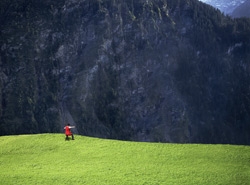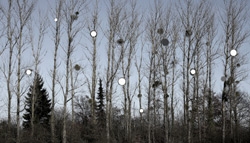Echoes between West and East
Text: Yanashita Tomoko
In a meadow surrounded by the Alps, a lone female plays the cello as if engaging in a dialogue with her own echo. The sound rings out beautifully. But equally memorable are the long silences. First presented at the 2003 Venice Biennale, the video work L’écho is one of Tse Su-Mei’s signature works. But Tse not only created the video; she also played the cello.
 L’écho, 2003
L’écho, 2003Courtesy Peter Blum Gallery, New York
Commissioned by MUDAM for the 50th Venice Biennale
“In the beginning, I used more directly the theme of music and musical education in my works. Later my interest turned more into music as an artistic language.”
In 2006 for example, she used an extract from an existing piece by Shostakovich in a video called Mistelpartition (Mistle Score), in which wintery branches of mistletoe turn into illuminated notes, transforming the landscape into a musical score. In all of her creations, sound and image are strongly and poetically related to create audible images or visual sounds.
Raised by a British mother and Chinese father, both professional musicians, Tse uses experiences from her background in her work. This perhaps explains why many of her works seem to exhibit multiple perspectives in a very personal way, unrestricted by the framework of art history. As well, Tse employs a variety of creative methods, including sculpture, video, installation, and photography.
“Sometimes I have flashes of ideas, and then of course I need to work them out, and they end up naturally reflecting my Western and Eastern origins. In the installation East Wind, the cypress trees, which are typically Western trees, are leaning as if blown by an east wind and this shows in general in my work there might be an Eastern influence, like a slight breath, even if visually it’s not directly Asian art. Still, I resist these kind of categorization.”
 Mistelpartition (Mistle Score), 2006
Mistelpartition (Mistle Score), 2006Courtesy Peter Blum Gallery, New York & Tim Van Laere Gallery, Antwerp
One can also infer from the works that touch on such subject matter as bonsai and the novels of Kawabata Yasunari an interest in Japanese culture and Eastern thought. This may also be related to an empathy with Zen, of which John Cage – often cited as one of Tse’s influences – was a devotee.
“I’m interested in the distinctly Japanese notions of time and silence. It would be wrong to say that I’m not interested in the philosophy of Zen, but I think I need more time to understand it. In our world, our rhythm of life becomes more and more stressful. But at the same time, for me, these tense moments are also important to appreciate the more calm moments. I like to be inspired by various and even opposite worldviews when I’m expressing myself.”
Although Tse freely combines contradictory elements in her work, her aim is not to take the middle-of-the-road course but to lead the viewer to new discoveries by clearly identifying the boundaries of each. The injection of humor into serious pieces also stems from this distinctive sense of balance.
“For example, in the work with the cypress trees, the way the trees are pulled by strings is quite funny. Humor to create some distance and the smile on people’s faces shows a nice understanding of my work.”
A major solo exhibition of Tse’s work opens at Art Tower Mito in February. Tse stresses the importance of entering into a dialogue with the space of the museum. We look forward to seeing what kind of world she presents this time.

Tse Su-Mei
Born 1973 in Luxembourg, based in Berlin and Luxembourg. The Luxembourg pavilion, featuring her work, was winner of the Golden Lion at the 50th Venice Biennale (2003). She has recently shown work in H BOX (2007, touring Paris, London, Yokohama and others) and at the 2008 Singapore Biennale. Her first solo show in Japan is being held at the Contemporary Art Gallery, Art Tower Mito from 7 February to 10 May.
Originally printed in ART iT 22 Winter/Spring 2009
